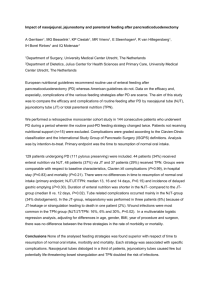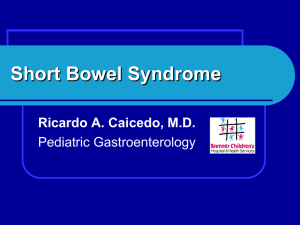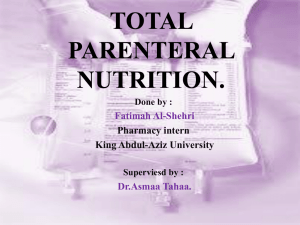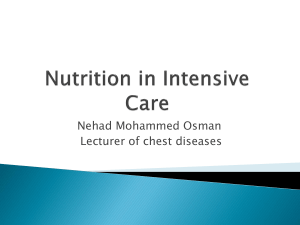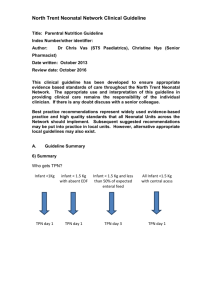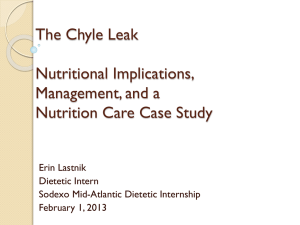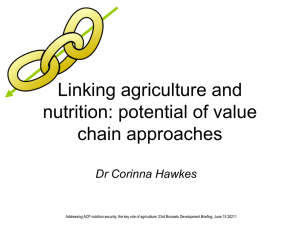The Value of TPN in Preoperative Malnourished Patients
advertisement
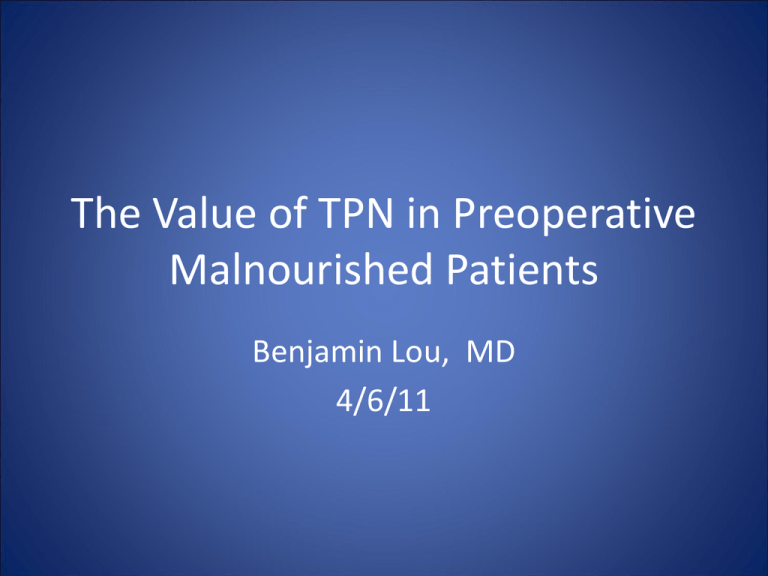
The Value of TPN in Preoperative Malnourished Patients Benjamin Lou, MD 4/6/11 Introduction • TPN (total parenteral nutrition) – First practiced in Europe during 1946-54 French-Vietnam War. (1) – Described by Wilmore and Dudrick in 1968 in a infant with intestinal atresia. (2) • • • • • Acceptance as safe, life-saving intervention Risks/Disadvantages Previously accepted use of TPN questioned Current literature favors enteral nutrition Goal of nutritional therapy: preserve lean body mass, maintain immune function, avert metabolic complications (6) Malnutrition • May be present on admission, or develop during hospitalization • 50% of hospitalized patients: moderate malnutrition (3-5) • 5-10% severely malnourished (3-5) • Rapid weight loss of >10% of normal body weight: – Higher infectious complications (60% septic complications) – Increased length of hospital stay – Increased mortality • Albumin <3.0 or poor nutritional status by Subjective Global Assessment – 3.5 to 4 fold higher postop complication rate (7) Subjective Global Assessment Nutritional Risk Index • Screening tool to assess risk of complications • Useful in pts undergoing noncardiac, abdominal surgery. • NRI= (1.519 x albumin) + (41.7 x present wt/usual wt) – – – – NRI NRI NRI NRI >100 97.5-100 83.5-97.5 <83.5 normal mild malnutrition moderate severe • Disadavantage: relies on weight (affected by volume retention in cardiac, renal, hepatic dysfunction) Identifying those at risk • Lab markers: – Serum Albumin < 3.0 g/dL – Serum Transferrin <220 mg/dL – Prealbumin/retinol binding protein • • • • • • Recent weight loss over 3 months of > 10% normal body weight. Nitrogen balance determination Indirect calorimetry Midarm muscle circumference Delayed hypersensitivity reactions to injected antigens Functional impairment of ventilatory effort or muscle response by electrical stimulation • Various indices and equations for stratifying risk of complications/mortality (PNI) – Rely on heavily on Albumin • #1: Physician history and physical examination (8) Enteral vs TPN • Enteral feedings preferred if tolerated. – Lower risk • Lower septic morbidity (burn/trauma) • Lower intraabdominal abscess/pneumonia rates – Prevents gut mucosal atrophy – Maintains barrier function – Normal gut flora/immmunocompetence – Hepatic protein synthesis – Lower cost (including complications) TPN indications – – – – – – – – – – – – Nonfunctional GI tract Gastrointestinal cutaneous fistulas Congenital GI disorders Short bowel syndrome Acute radiation enteritis Chronic obstruction/pseudoobstruction Intractable diarrhea/emesis Acute pancreatitis (severe, when intolerant of enteral) Prolonged ileus Motility disorders Acute chemotherapy toxicity Weight loss preliminary to major surgery Perioperative Total Parenteral Nutrition in Surgical Patients The Veterans Affairs Total Parenteral Nutrition Cooperative Study Group* N Engl J Med 1991; 325:525-532August 22, 1991 NEJM • • • • • VA TPN cooperative study group P= 395 malnourished patients M Laparotomy or noncardiac thoracotomy Groups: – TPN 7-15 days preoperatively + 3 days postop – No TPN • Monitored patients for 90 days postop NEJM Results • 30 day major complication rate similar. (25.5 vs 24.6%) • 90 day mortality rate (13.4 vs 10.5%) • Higher infectious complication rate in TPN – 14.1 vs 6.4% – For those with borderline or mild malnourishment • Severely malnourished w/TPN (NRI <83.5) – Lower noninfectious complications (5 v 43%) – No increase in infectious complications Indications for Periop Support (1) • Emergent operation: no indication – If anticipated NPO status >7 days: nutritional support indicated immediately postop – If suspected during OR: enteral access considered, ie. Jejunostomy • Elective operation: – Unable to eat, operation delayed >5 days: TPN – No delay, mild to mod malnourished: no TPN – Severe malnourished, 5-10 d TPN preop SCCM/ASPEN guidelines • Guidelines by panel of Society of Critical Care Medicine and American Society for Parenteral and Enteral Nutrition: – offer basic recs supported by current review and analysis of literature. – Range from large randomized trials to case series/expert opinion. • Meant for adult medical and surgical critically ill patient populations. • Enteral nutrition is the preferred route. – Well documented in numerous RCT: crit ill, trauma, burns, head injury, major surg, acute pancreatitis. – Reduced infectious morbidity • Focus today will be their guidelines for Preop TPN use. Indications for TPN • No preop malnutrition, if enteral route not available, NPO >7days – Meta analysis Braunschwieg et al. (7 studies) • No nutritional support: reduced infectious/overall complications vs TPN in first 7-10 days. – Sandstrom et al. • NPO >14 days: higher mortality and extended LOS vs TPN • START TPN after 7 days (level IV/V evidence) Inidications for TPN • Preop malnutrition, enteral route not available – Recent weight loss >10-15% or <90% ideal body weight – Heyland et al. Fewer overall complications vs no nutrition – Braunschweig et al. Higher mortality and infection rate in pts with no nutrition vs TPN • Start TPN without delay (level II) TPN indications • Major upper GI surgery (esophagectomy, gastrectomy, pancreatectomy, reoperative abdominal surgery), enteral route unavailable • Malnourished – TPN start 5-7 days preoperatively and continue postop • Postop – If enteral route still unavailable after 5-7 days: start TPN. – TPN beneficial if duration of therapy >7 days TPN in major upper GI surgery • Critically ill pts: increased mortality and complications with TPN vs no nutrition • Surgical pts: no difference in mortality and decreased complications with TPN – Klein et al. (13 studies) • Benefits with preop TPN x 7-10 days and postop. • 10% decrease in infectious complications – Postop TPN only: lose benefit • Level I Transitioning from TPN to Enteral • Periodic repeated efforts: start enteral nutrition. • Tolerance of enteral nutrition: >60% caloric requirements reached – TPN may be stopped. • Level V References • • • • • • • • 1) Archer SB, Burnett RJ, Fischer JE. Current Uses and Abuses of Total Parenteral Nutrition. Advances in Surgery Vol. 29: 165-189. 1996 2) Wilmore DW, Dudrick SJ: Growth and development of an infant receiving all nutrients exclusively by vein. JAMA 203:860-864, 1968. 3) Bistrian BR, Blackburn GL, Hallowell E, et al: Protein status of general surgical patients. JAMA 230: 858-860, 1974. 4) Bistrian BR, Blackburn GL, Vitale J, et al: Prevalance of malnutrition in general medical patients. JAMA 235: 1567-1570, 1976. 5) Coats, KG, Morgan SL, Bartolucci AA, et al: Hospital-associated malnutrition: A reevaluation 12 years later. J Am Diet Assoc 93: 27-33, 1989. 6) Buzby, et al. Perioperative Total Parenteral Nutrition in Surgical Patients. The Veterans Affairs Total Parenteral Nutrition Cooperative Study Group. N Engl J Med 1991; 325: 525-532. 7) Detsky AS, Baker JP, Mendelson RA, et al. Evaluating the accuracy of nutritional assessment techniques applied to hospitalized patients: Methodology and comparisions. JPEN J Parenter Enteral Nutr 8: 153-159, 1984. 8) Jeejeebhoy KN, Baker JP, Wolman SL, et al. Critical evaluation of the role of clinical assessment and body composition studies in patients with malnutrition and after parenteral nutrition. Am J Clin Nutrition 35: 1117-1127, 1982.
